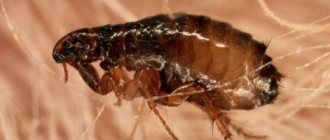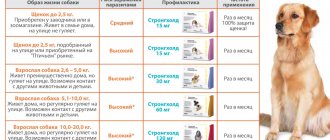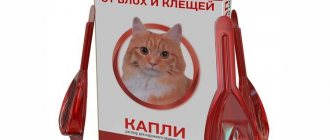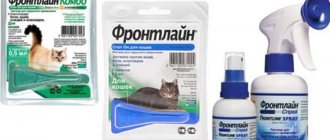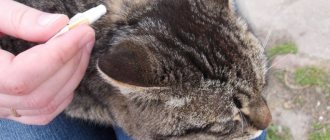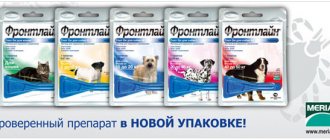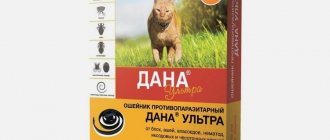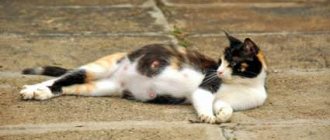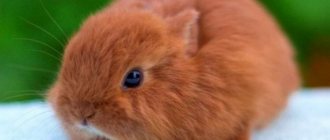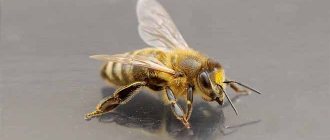Pets living side by side with people have long turned from just animals into family members. Many owners watch their dogs much more closely than they watch themselves, and there is a reason for this. The fact is that it is much easier for pets to get some kind of unpleasant illness than for us. They are constantly in danger: in particular, many problems arise due to infection with various ectoparasites, such as fleas, ticks, lice eaters, etc. These harmful insects not only cause inconvenience to our pets in the form of constant itching, but also destroy the animal’s skin and provoke the development of many serious diseases. Today on the veterinary market there are a large number of products that can completely cure the suffering of our furry family members. In this article we will talk about one of them: Dana Spot-on for dogs.
"Dana Spot-on" for dogs: instructions for use
Chemical composition of the drug "Dana Spot-On"
Treating pets for skin parasites using drops is convenient and simple - you just need to cut off the tip of the dropper and squeeze the contents onto the skin. The manufacturer has taken care of the consumption rates for small animals, which eliminates complex dosage calculations - it is enough to know only the weight of the pet.
The effect of the drug occurs within 24 hours after application and lasts for 4–6 weeks from the start of treatment. During this period, the cat is protected and is not attacked by parasites, which die from contact with the treated skin of the animal.
The organization that developed the product is Russian.
The active ingredient in the chemical composition of the medicinal solution is fipronil (fipronil 50 mg), which destroys skin parasites, causing paralysis of the nervous system.
Excipients serve to improve the distribution of fipronil throughout the skin and reduce inflammatory processes:
- isopropyl alcohol, isopropanol (disinfectant) - 300 ml;
- dimethylformamide (dissolves chitinous membranes, affects the kidneys, liver, inhibits the nervous system of ectoparasites) - 100 mg;
- citric acid (preservative) - 1 mg;
- polyethylene glycol (binder base) - 1 ml.
Did you know? Even before our era, Aristotle was one of the first to describe the effect of sulfur as an insectoacaricidal agent to rid a person of lice. And the army of Alexander the Great used chamomile powder (pyrethrum) for these purposes.
Release form
Dana Spot-On drops are produced in special metal-polymer dropper tubes with a volume of 0.5, 1.0 and 1.5 ml, which is very convenient for small pets. Manufacturer's cardboard box contains:
- dropper tubes of the same volume - 3-4 pieces;
- instructions.
Larger packaging has been developed for veterinary clinics - 15 ml dropper bottles.
pharmachologic effect
Therapeutic drops "Dana Spot-On" belong to the group of acaricidal phenylpyrazoles, obtained through chemical synthesis to destroy external parasites. It has long-lasting insecticidal toxicity and is used in the recommended doses to get rid of skin parasites.
The active ingredient of the medicinal solution is fipronil, which was first synthesized in 1987 and is characterized by the following features:
- contact-intestinal mode of action;
- the protective effect occurs upon contact with insects;
- parasites do not have resistance (resistance) to fipronil;
- effective and long-lasting residual protection;
- selectivity (selectivity) of influence;
- is broken down in the animal’s body and is quickly eliminated.
Did you know? Modern craftsmen were able to make the legend of Lefty come true and shoe a flea. One golden flea horseshoe by master Aldunin N.S. weighs 0.04419 mcg. You can fit 2,500 pieces of such horseshoes on a match head.
It is used in the fight against harmful insects - in veterinary medicine against pre-imaginal (before sexual maturity) and imaginal (sexually mature) stages of development of the following parasites:
- fleas that feed on blood and cause allergic dermatitis;
- lice that feed on blood and cause siphunculatosis;
- lice eaters that feed on skin particles and hair and cause severe irritation of the epidermis and trichodectosis;
- mites: sarcoptoid mites, feeding on lymph and dead epithelium, ixodid bloodsuckers and carriers of encephalitis and borreliosis, demodectic mites (acne mites), living inside or near hair follicles.
Exposure to fipronil leads to blocking of GABA (gamma-aminobutyric acid)-dependent receptors and disruption of the passage of nerve impulses in the plasma membranes of cells, which leads to paralysis and death of ectoparasites within 7 hours from overexcitation.
After treating the pet, fipronil is concentrated in the skin - the dermis, hair follicles and sebaceous glands, which causes a long-lasting protective effect. It is not absorbed into the blood and tissues of the animal, is metabolized and quickly eliminated from the body. Ectoparasites are unlikely to become accustomed to the drug.
The role of ectoparasites in the life of cats and dogs
Fleas are, first of all, ectoparasites. This term includes insects and arachnids that live temporarily or permanently on the surface of the skin, never penetrate the body and feed on their host - skin cells, blood, hair and other products. It is worth emphasizing right away that the exchange of fleas between a dog and a cat is impossible - the feline type of parasites live on the cat, and the canine type - on the dogs.
No matter how unusual it may sound for many readers, a flea and its owner - a dog or cat - have been living together since ancient times. Of course, from much earlier than these animals were domesticated by humans. The word “commonwealth” was not chosen by chance; fleas live and feed at the expense of their owner, but they also benefit him. This phenomenon is called synergy and was described in this article.
But, if having fleas is so useful, why expel them, and why does the pharmacological veterinary industry produce so many different drugs against parasites?
It's all about population size, that is, the total number of fleas on one individual dog or cat, and, in addition, the general health of the pet. The blood of healthy animals contains substances that have a toxic effect against ectoparasites. As a result, fleas are constantly depressed, do not feed as often, and their reproduction process also slows down. This allows the parasite population to be kept within limits that are beneficial for the animal.
As soon as the dog or cat’s body weakens, as a result of insufficient nutrition or care, the appearance of infectious and parasitic diseases, the amount of these flea-inhibiting substances in the blood decreases noticeably, the fleas seem to wake up and begin to lead a more active lifestyle, multiplying uncontrollably. By the way, approximately the same picture is observed in young and elderly animals. For the former, protection against fleas does not yet work sufficiently functionally, and for the latter, it is already close to decline.
Useful Links Find out more about the benefits of flea collars for dogs using this link.
In some cases, the flea population may increase spontaneously, without any apparent reason. An attentive owner will immediately notice the difference:
- The animal's coat loses its shine and becomes dull.
- Constant molting begins. The hairs of the coat are first shed singly, then in whole tassels.
- The animal is actively and constantly itching.
- At night, dogs may yelp and whine from multiple bites.
- Upon careful examination of the coat, you can see a large number of fleas scurrying between the hairs.
It is necessary to fight fleas only if their concentration exceeds permissible standards.
Indications for use
The presence of ectoparasites can be noticed by the cat's intense scratching. If you shake off the litter into a wet bath, you may notice blood stains—this is flea excrement dissolving on the wet surface.
Important! After treatment for infection with ectoparasites, it is necessary to conduct a course of anthelminthic treatment for the cat.
Localization of parasites is usually observed in the neck area, on the head and in the tail area, where the skin is thin and sensitive, rich in blood vessels, and it is more difficult for the animal to lick the fur and catch parasites. When scratched, crusted wounds appear at the sites of bites, the skin peels, and hair loss is possible. The presence of tangles and matted fur is especially dangerous - this is a place where lice accumulate and a source of damage to the skin.
Ectoparasites themselves are not as dangerous as the consequences that can result from prolonged and untreated infestation:
- often skin parasites are carriers of helminths;
- possible infectious diseases from tick bites (encephalitis, borreliosis, tularemia);
- infected pets may become weak and unable to eat or rest properly;
- Inflammatory processes on the skin and suppuration in areas of scratching are possible.
Infection occurs when walking on the street, contact with infected animals, or from bedding. Parasites can be brought into the house on clothes and shoes from the street or from basements. In this case, infection is also observed in domestic cats that do not go outside.
Infection with exoparasites
Dogs and cats have long been home to fleas. It is even believed that this neighborhood is beneficial for both parties. A healthy animal has substances in its blood that inhibit the growth of parasites and slow down their activity. As a result, fleas do not cause any concern to the owner.
But as soon as the animal’s immunity decreases, the parasites begin to actively multiply. In this case, their population grows greatly and begins to cause only harm. This especially applies to pets. The pet begins to itch, suppuration may appear in the scratches, and the condition of the coat worsens. Young and old animals are especially affected by fleas. In addition, if a pet becomes infected with parasites on the street, they can get some kind of infectious disease.
This possibility is always present even for those animals that only walk in the yard. And if the owners take their pet to the forest or to the country, it can pick up more than just fleas. Exoparasites also include ixodid and ear mites, lice, and lice. All of them can carry infectious diseases and cause serious trouble to the animal.
Side effects and contraindications
Side effects are rare. Among them, when treating domestic cats, the following manifestations are possible:
- individual sensitivity and intolerance;
- allergic reactions in the form of redness of the skin and hair loss;
- pet hyperactivity.
The procedure cannot be performed on weakened, exhausted and sick cats, or on those recovering from infectious diseases. Drops cannot be used for ear scabies, which are caused by other types of mites. Do not instill in the ears or use for injections. The skin on the withers should not be damaged.
Instructions for use and dosage
The rate of treatment depends on the weight of the cat, so you need to choose the appropriate packaging for the dropper:
- less than 3 kg (kittens fall into this category) - 0.5 ml;
- over 3 kg - 1 ml.
During treatment, you must adhere to the following rules:
- The drops are not applied to the hair, but directly to the skin, which absorbs the protective medicine. To do this, a parting is made in the fur in places that prevent licking (withers, neck, between the shoulder blades). The drug is squeezed out of the dropper along the parting. The skin should be dry and intact.
- The use of drops for pregnant and lactating cats should be discussed with your veterinarian. Kittens are prescribed drops no earlier than 12 weeks.
- The animal is not washed three days before the procedure in order to preserve the sebaceous lubricant into which the drug is absorbed. After the procedure, you can bathe your pet only after three days, so as not to wash off the protection.
- Treatment frequency: 1 time per month as needed. If the pet is frequently bathed or the treatment is ineffective (fleas appear that have hatched from nits, or the room has not been sanitized), treatment is allowed once every two weeks.
- You need to treat the bedding, the cat's sleeping area, as well as carpeting, upholstered furniture and baseboards in the apartment with insecticidal agents approved for use. Parasite eggs can be found outside the animal, and the fleas themselves can hide in secluded corners. After each cleaning, empty the dust bag of the vacuum cleaner.
- It is advisable to mark the date of the procedure on your calendar. This way you can control the timing of the drug’s effect and the results of protection.
- In the instructions for the drug, you should pay attention to contraindications, and if in doubt, consult a veterinarian.
Recommendations for working with the drug
There is a list of rules that a person who owns a dog that needs to be cured of fleas or other ectoparasites must follow. First of all, it is necessary to carry out processing in elementary protective equipment, such as:
- latex gloves;
- mask for the face;
- unnecessary home clothes.
- Latex gloves are an adequate measure of protection against contact of the product with the skin.
- While applying the drug, do not eat, drink, smoke, etc.
- For the next 24 hours, the animal treated with the product is literally untouchable. You can’t touch him, even if the pet fawns on you - it’s better to endure it for a while. Otherwise, you will remove the medicine from the animal’s fur and reduce its effectiveness, and even poison yourself with this insecticide.
- If you have an allergic reaction to the components of the drug, avoid direct contact with it.
- If you accidentally dropped the drug onto the skin, mucous membranes of the eyes, mouth, etc., immediately wash the area with plenty of warm water, if possible with soap.
If you have an allergic reaction, go to your doctor and take the product label with you
- Used packaging (both boxes and dropper ampoules) is strictly prohibited from being used after the medicine has been removed from it. Dispose of the packaging so that no one else can be harmed.
Drug overdose
In case of overdose, the following reactions in cats are possible:
- temporary lethargy and lack of appetite;
- excessive salivation and lacrimation;
- nausea, vomiting;
- weakness and tremors in the muscles.
Symptoms may be short-lived and resolve spontaneously.
In case of complex manifestations, the drug should be immediately washed off with soap and water and contact a specialist to remove the product from the animal’s body.
Important! The insectoacaricidal drug "Dana Spot-on" is toxic to rabbits, bees, beneficial insects, fish and other organisms that constantly live in the aquatic environment (hydrobionts).
Indications and restrictions
The drug is effective for otodecosis in animals.
Veterinarians recommend an insectoacaricidal drug for animals from 3 months of age when infection is confirmed or to prevent diseases such as:
- Acarosis caused by the following insects: fleas;
- lice eaters;
- lice.
- arthropods;
Storage conditions and shelf life
Pipettes should be stored undamaged, in a dry and dark place, at a temperature of +2...+25°C, away from food and feed. The storage location should be inaccessible to children, who may be interested in the almost toy-like appearance of the dropper tube.
Shelf life: 2 years from the date of issue. Do not use expired medication
Unused drug and empty droppers must be disposed of in compliance with environmental legislation and safety regulations.
Package| 1 pipette 1.5 mg. | |
| Price, lei: | 20 |
DANA ULTRA drops on the withers for dogs
Packaging 50 ml DANA drops on the withers Diazinon (diazinon) TRADE NAME OF THE DRUG DANA / DANA DOSAGE FORM Solution for external use. COMPOSITION AND RELEASE FORM Diazinon – 50 mg/ml, auxiliary components. The drug is available in PVC pipettes: - for dogs of small and medium-sized breeds - 4 pipettes of 1.5 ml each, in a cardboard box along with instructions for use. PHARMACOTHERAPEUTIC GROUP Insectoacaricide. PHARMACOLOGICAL PROPERTIES Diazinon, which is part of the drug, has an insecticidal and acaricidal effect against lice, fleas, lice, ixodid, sarcoptic and demodectic ticks that parasitize dogs and cats. Auxiliary components improve the penetration of diazinon to the localization sites of parasites and reduce inflammatory processes in the skin. After skin application of the drug, diazinon, which is part of it, accumulates in the epidermis, hair follicles and sebaceous glands and has a long-term insectoacaricidal effect. Given the degree of impact on the body, it is classified as a moderately hazardous substance (hazard class 3 according to GOST 12.1.007-76). When applied to the skin in recommended doses, it has no irritating, resorptive-toxic or sensitizing effects. In case of contact with eyes, it causes mild irritation. INDICATIONS FOR USE The drug Dana is used to treat dogs, cats, puppies and kittens with entomoses (lice, fleas, lice), sarcoptic mange, notoedrosis, otoedectosis, demodicosis, infestation with ixodid ticks and protection of animals from attacks by ectoparasites. CONTRAINDICATIONS Pregnant and lactating females, patients with infectious diseases, weakened, exhausted and convalescent animals, puppies and kittens under 10 weeks of age, as well as animals with individual intolerance to the components of the drug cannot be treated. Do not apply to wet or damaged skin. METHOD OF APPLICATION AND DOSES For the treatment of dogs and cats with entomosis, as well as their protection from attacks by lice, fleas, lice and ixodid ticks, cut off the tip of the dropper ampoule and, spreading the hair, apply directly to the skin at several points along the spine (to prevent licking of the drug ) at the base of the head, on the neck and between the shoulder blades in the following dosage:
The effect of the drug appears after 12-24 hours and lasts against fleas, lice, lice - for 2 months, to prevent attacks by ixodid ticks - up to 1 month. Repeated treatments of animals are carried out according to indications, but not more than once a month. It is not recommended to bathe the animal 3 days before and 3 days after treatment. After this period, bathing the animal does not reduce the protective effect of the drug. To destroy parasite larvae, the animal's bedding is treated with Dana insecticidal spray. A single treatment protects the animal from repeated flea attacks for at least 1 month, and from tick attacks for at least 2 weeks. To destroy ixodid ticks on the animal’s body, 1-2 drops of the medicine are applied to the tick and the place of its attachment to the skin. If the tick does not fall off spontaneously within 20-30 minutes, it is carefully pulled out of the body and destroyed. To treat dogs and cats with ear scabies (otodectosis), both ears are cleaned, then 3-5 drops of the drug are instilled into each ear, after which the auricle is folded in half lengthwise and its base is massaged. Both ears must be treated with the drug, even in cases of otodectosis affecting one ear. The treatment is repeated once a day with an interval of 5-7 days, repeating the course 2 times. If necessary, the course of treatment is repeated. When dogs and cats are affected by sarcoptic mange, notoedrosis and demodicosis, the drug is applied in a thin layer to the affected areas, evenly distributed from the periphery to the center, covering the borderline healthy skin up to 1 cm. To prevent licking of the product, the animals are put on a muzzle or the jaws are closed with a loop of braid, which is removed through 15-20 minutes after treatment. The treatment is carried out once a day with an interval of 7-10 days, repeating the course 3-4 times until the animal’s clinical recovery, which is confirmed by two negative results of skin scraping tests. Animals with large affected areas are treated in two doses with an interval of 1 day, applying the drug first to one and then to the other half of the affected body surface. SIDE EFFECTS When using the drug in accordance with these instructions, side effects and complications in animals, as a rule, are not observed. In some animals, if there is increased individual sensitivity to the drug and signs of skin irritation appear, it should be washed off with water and detergent and, if necessary, desensitizing therapy should be carried out. OVERDOSE In case of significant overdose, the animal may experience excessive salivation, muscle tremors, and vomiting. In this case, the drug is washed off with water and detergent and general measures are used to remove it from the body. INTERACTION WITH OTHER MEDICINES The drug Dana Ultra should not be used together with other insectoacaricidal drugs for treating animals. STORAGE CONDITIONS In sealed manufacturer's packaging, separate from food and feed, in a dry place, protected from light, at a temperature of 2 °C to 25 °C. The medicine should be stored in places inaccessible to children and animals. EXPIRATION LIFE 2 years. Do not use the drug after the expiration date.
Analogs and price
You can purchase Dana Spot-On drops in veterinary clinics, pet stores, or order online:
- for cats over 3 kg - the price is 95 rubles;
- for cats up to 3 kg - for 70 rubles.
There are analogues of the drug:
- Fiprist Spot On drops for cats - 200 rubles;
- “Frontline drops on the withers” (France) - 420 rubles.
Prices are average and shown for comparison.
So, correct diagnosis and use of Dana Spot-On drops in accordance with the instructions will save your pets from such unpleasant problems as infection with ectoparasites. The main thing is to respond to alarming symptoms in a timely manner.
Precautionary measures
Veterinarians, based on research, recommend avoiding the use of Dana Spot if the animal has pathological processes or the body is weakened, as well as during upcoming surgical interventions. You should refrain from using the drug if the cat is pregnant or nursing cubs. It is not recommended for kittens less than 2.5-3 months of age.
Doctors recommend using rubber gloves when carrying out therapeutic or preventive measures using Dana Spot-On. While working, it is prohibited to eat, smoke or drink.
